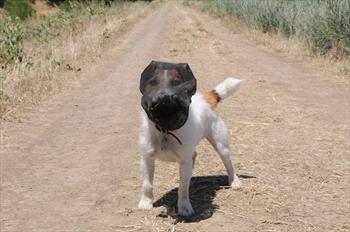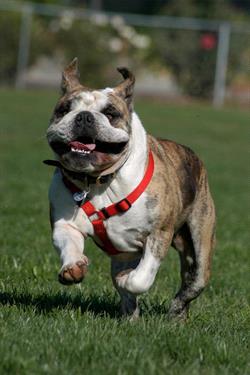Summer conjures up images of shorts and bikinis, but for dogs, at least those in California, the “in” piece of petwear is protective headgear. Not protection from crashes or spills related to athletic play; protection from those pesky grass awns called foxtails. From afar, these awns look like wheat but close up they look more deadly. The awns fall into ears, eyes and get sniffed into the nose and once they have a foothold, their shape ensure they travel only one way—in deeper and deeper.
For dogs in California who like to go on hikes or into yards and parks where foxtails sometimes lurk, a product that can prevent foxtail assaults on the head can save us humans from expensive veterinary bills and our pets from a lot of pain.
I have been testing one of these protective product, Outfox® Field Guard (https://outfoxfordogs.com/), for the last month. This nylon mesh product which costs between $46–$48 depending on size, works by covering the dog’s entire head —so the ears, eyes, and nose are protected. The mesh makes it breathable and the black coloring helps it stay cool.
At first glance, it looks pretty ridiculous. In fact I think it makes my dog look like an executioner. But if it worked, my dog and I would be able to enjoy all of the great foxtail-riddled hiking trails that we usually have to avoid every summer.
Will my dog wear this?
You might wonder if your dog would even wear something weird like this on his head. I had some doubts that my Jack Russell Terrier Jonesy would. He hates wearing hats, vests, and even bandages on his legs. Before you think that I dress my dog up like we’re playing “tea party”, I want to clarify that the hats are only for photo shoots and the vest is for therapy/service work. He also hates wearing clothes even though they have been paired with food. I’m guessing I would have to pair them with food for about a month to get him to accept wearing them happily!
If Jonesy was going to have fun on his hikes while wearing this field guard, he needed to enjoy wearing it. So, in order to train a positive association, I started by holding chicken near the opening of the field guard so he’d stick his nose through. Once he readily devoured the chicken, I plunked more chicken into the field guard and held the opening wide so Jonesy could easily stick his head in to get the treat. Basically my goal was to turn the mesh field guard into a big doggie bowl for him. After a several-minute session, once he had already stuck his head in and was eating, I released my hold on the elastic opening so that it tightened around his neck. I let him wear the field guard on his own while finishing the bonanza of kibble and treats that were in it. Once he was finished, I took the head gear off. I repeated a session later in the day and he happily stuck his head in to what he now considered a nylon mesh feedbag.
Can he play fetch with it on?
Now we were ready to test it on a hike on a trail with foxtails. At the head of the trail Jonesy was ready to go. He stood with tennis balls dancing in his eyes, ready to explode after the tennis ball he was expecting me to throw down the trail. I held out the Outfox® field guard with big wad of chicken in it and he stuck his head right in. Then I strapped it onto his collar and tightened the elastic around his neck. I released him and he was off, like a bullet, heading in the direction he was hoping I’d toss the ball.
I hurled the ball using a chuck-it® and as Jonesy disappeared into the tall grass, I wondered if he would be able to pick the ball up. I could see his tail flagging in the distance, so I knew he was on the ball’s scent. Then after a couple of anxious moments, I saw him bounding back. And yes! He had the tennis ball in his mouth!
Throughout the rest our 3-mile fetch session—Jonesy repeatedly picked up the ball and brought it back with no problems even with a super-sized tennis ball I brought too—the one that requires his mouth open wide like a yawning hippo. Jonesy could even swim with the field guard on, although it didn’t miraculously cure his poor dog-paddle form. He did, however have difficulty grabbing the ball when it was floating in the water. So at one point I did take the field guard off so that he could grab it out of the water, after which I put it back on so he could again be protected.
Outfox® Field Guard passes the foxtail test
The Outfox® Field Guard worked well for foxtails too. The grass was filled with foxtails but they stuck to the outside of the mesh instead of flying into his eyes, ears or being snorted into his nose. So, while an army of foxtails assaulted my socks, and consequently my ankles and feet, Jonesy’s head was safe even when he was sniffing for squirrels or searching for his ball. As an added bonus, when the ball got covered with burrs, the field guard acted like a glove to help protect Jonesy’s mouth so he could still pick the ball up.
We continued testing this product for a month and even by day 2 it was clear that Jonesy didn’t need food in the field guard to happily stick his head in. He also had no problem running like a stampede of horses at full speed after the ball or after squirrels. He did rip the mesh of his size-small field guard when he was hunting for squirrels near a cyclone fence. It got snagged on the fence and ripped when he pulled it away. The manufacturer of Outfox® Field Guard does guarantee the product under normal wear and tear, such as if it had gotten ripped on a stick while playing fetch. But a snag due to a cyclone fence while chasing squirrels doesn’t count. Since the snag incident, I have been using my back-up medium-sized field guard, and it has held up well. I just make sure Jonesy’s focused on me instead of squirrels when we get close to cyclone fences.
Overall, the OutFox® Field Guard has added extra fun to our summer walks.
To order this product, contact OutFox® Field Guard, located in Walnut Creek, CA. Go to www.outfoxfieldguard.com or call (800) 261-7737.







